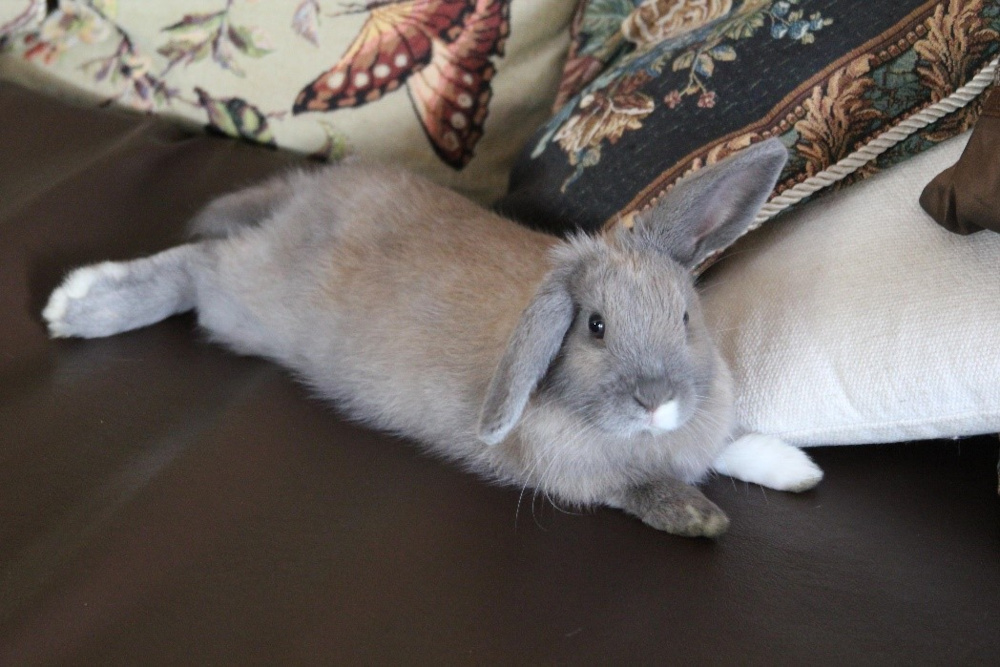
Desexing has numerous benefits for both male and female pet rabbits including reducing problem behaviours, facilitating easier bonding with new rabbits joining the family, preventing unwanted pregnancies, and minimising health issues in the future such as cancer of reproductive organs.
Terminology
A female rabbit is called a ‘doe’, a male rabbit is called a ‘buck’, and baby rabbits are known as kittens or kits. Desexing a female rabbit is known as spaying where the entire reproductive tract is removed including the ovaries and uterus. Desexing a male rabbit is known as castration where both testicles are removed. Desexing is also referred to as ‘neutering’ or sterilisation. Non-desexed female or male rabbits are referred to as ‘entire’.
Why should I desex my rabbit?
To modify behaviour
- Urine spraying is normal territorial behaviour seen in rabbits. It can become a problem behaviour in pet rabbits if continual spraying is occurring outside of their litter box. It is seen particularly in entire bucks, but it can occur in entire does (and sometimes even in desexed rabbits). Desexing may assist with preventing or reducing this behaviour and can also contribute to successful litter box training.
- Entire does may display behaviours associated with hormonal changes. This can include aggression towards other rabbits, pets and humans or other behaviour such as building a nest by pulling out tufts of hair from their dewlap (loose skin under the neck) and reacting aggressively if approached in the nest. Pulling fur from their dewlap is a normal behaviour in entire does and this behaviour may take some time to cease after desexing, especially if the doe is desexed later than six months of age. It can occasionally be seen in desexed does, especially if kept with entire males, or if the does were desexed later in life. If an entire doe is kept with a desexed buck, she may experience ‘phantom pregnancies’ where she displays pregnant doe behaviours, which can even include lactation.
- Entire bucks can also show behaviour due to hormonal changes undergone during maturation, such as mounting and aggression. Desexing can reduce the incidence of these behaviours as it decreases testosterone levels which play a key role in these behaviours.
To assist in bonding rabbits
Rabbits are social animals and, so, having more than one is important for their wellbeing, (see our article What companionship do rabbits need?) When bonding rabbits of the opposite sex, desexing is imperative to prevent unwanted litters. Desexing can also prevent unwanted behaviours that can be seen when attempting to bond two entire rabbits such as fighting and urine spraying. Desexing can help to reduce the hormones that influence these behaviours, thereby reducing the incidence of these problem behaviours in same sex or opposite sex pairs. Households with only one rabbit should still desex their rabbit as there are numerous health and behaviour issues associated with rabbits remaining entire (covered in the sections below on Behaviour and Health). In addition, pet rabbits who have outdoor access may breed with wild rabbits.
Health
Does are likely to develop uterine cancer if they are not spayed. In fact, more than 80% of entire does over three years of age will develop uterine cancer which is malignant, spreading to the lungs and liver. No treatment is available unless the disease is caught early. Early age desexing (at 16-20 weeks) can prevent this often fatal disease.
Entire does can also develop pyometra, an infection in the uterus – a painful and often fatal disease that is entirely preventable by desexing the doe when young.
Bucks can also develop testicular and/or prostate cancer, although this is less common than uterine cancer in does. Desexing can entirely prevent these potentially life-threatening diseases.
Preventing unwanted pregnancies
Rabbits have evolved to reproduce quickly; they are sexually mature at 4 months of age; pregnancies are short, lasting about a month; and the average litter size is five to eight kits. The doe can then become pregnant again within hours of giving birth. This means that a doe can produce as many as 30 young in a single year! Does can have kittens from as young as four months old, often with large litter sizes of at least several kittens. Does can breed nearly every month meaning they could have up to 12 litters a year – that’s a lot of rabbits!
Not only will you have to find homes for all these rabbits (and many shelters are already overflowing with unwanted rabbits), but pregnancy can also take a huge toll on the general wellbeing and overall health of your bunny.
Desexing your doe will not only prevent health issues associated with pregnancy, but also prevent the birth of unwanted rabbits.
When should I desex my rabbits
Desexing is best performed at a young age (16 to 20 weeks), so talk to your veterinarian when you first acquire your rabbits to find out more about the procedure and the recovery process to allow good planning. Generally, rabbits should live as part of a bonded pair of rabbits and desexing will assist with the bonding process. When planning to bond rabbits, it is best to have your rabbits desexed at least four to five weeks before introduction.
References
All-Party Parliamentary Group for Animal Welfare. (2021). Good Practice Code for the Welfare of Rabbits.
Crowell-Davis, S. L. (2007). Behavior Problems in Pet Rabbits. Journal of Exotic Pet Medicine, 16(1), 38–44.
Rabbit Welfare Association and Fund. (2023). Neutering – Castration and Spaying.
Royal Society for the Prevention of Cruelty to Animals UK. (2022). Neutering of Rabbits.
Sayers, I. (2010). Approach to preventive health care and welfare in rabbits. In Practice, 32(5), 190–198.
